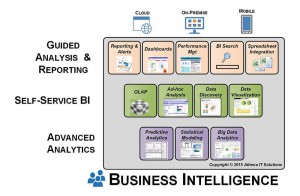Business intelligence (BI) is the ability of a company to make meaningful use of data it collects in the course of its day-to-day business operations (Kimble & Milolidakis, 2015). BI could play an important role in improving organizational performance by identifying new opportunities, highlighting potential threats, revealing new business insights and enhancing decision making processes… among many other benefits.
BI tool categories and styles
A set of BI tool categories and styles are identified and illustrated in the figure below.
Guided Analysis & Reporting
The Guided Analysis & Reporting category includes the traditional BI styles that business people have been using for years to perform recurring analyses of specific data. The underlying assumption in this BI tool category is that the data set and the metrics used will be predefined, but the analysis itself may vary based on the immediate needs of the information consumer when performing that analysis.
Self-Service BI
The Self-Service BI category includes the BI tools to perform ad hoc analysis of data. This analysis will either be a one-time-only analysis or the formulation of a recurring analysis that will be shared with others. Whereas Guided Analysis & Reporting tools operate with a pre-set collection of data and metrics, the Self-Service BI tools enable business users to add data and define new metrics when performing their analysis without requiring IT intervention (except from the data source access that is consumable for the BI tool).
Advanced Analytics
Finally, the Advanced Analytics category encompasses the tools data scientists use to create predictive and prescriptive analytical models. This includes predictive analytics, statistical modeling, data mining and Big Data analytics software. Here, data scientists tend to spend a great deal of time doing data ingestion, integration and cleansing.
The potential of Big Data
Currently, BI solutions mainly focus on structured and internal data of enterprises. As a result, a lot of valuable information embedded in unstructured and external data remains hidden, which could potentially lead to incomplete view of the reality and resultantly biased business decision making.
Given its potential of creating business value, Big Data has gained significant attention in recent years. By using Advanced Analytics, enterprises can analyze Big Data to learn, both, the current state of business and the constantly evolving processes such as consumer behavior.
The five main advantages of Big Data analytics
Generally, five main advantages of Big Data analytics can be identified:
- it increases visibility by making related data more accessible,
- it facilitates performance improvement and variability exposure by collecting accurate performance data,
- it helps in better meeting the actual needs of customers by segmenting the population,
- it complements the decision making with automated algorithms by revealing valuable insights,
- it yields new business models, principals, products and services (McKinsey, 2011).
Challenges of Big Data analytics
Besides these main advantages of Big Data analytics, the main challenge of Big Data analytics include lack of intelligent Big Data sources, lack of scalable real-time analytics capabilities, the availability of sufficient network resources for running applications, the demand in necessary expansion for peer-to-peer networks, the concerns about data privacy and information security regulations, the problems with data integration and fragmented data and lack of availability of cost effective storage subsystem of high performance (Ahmad & Quadri, 2015; Wang & Alexander, 2015). Also, the requirements of expensive software and huge computational infrastructure to do the analysis cause issues in the implementation of Big Data analytics for BI (Assunção et al., 2015).
Should I start collecting and using Big Data?
Knowing these advantages and challenges, should companies need to start thinking about collecting and using relevant Big Data? Some mind boggling facts are listed below that may support your thoughts:
- For a typical Fortune 1000 company, just a 10% increase in data accessibility will result in more than $65 million additional net income.
- Retailers who leverage the full power of big data could increase their operating margins by as much as 60%.
- The Hadoop (open source software for distributed computing) market is forecast to grow at a compound annual growth rate 58% surpassing $1 billion by 2020.
- At the moment less than 0.5% of all data is ever analyzed and used, just imagine the potential here.
Good read: check out the complete list of “Big Data: mind boggling facts everyone must read”.
The key to business success: ask the right questions
Despite the direction BI is evolving, one should keep in mind that the best data and the most advanced analytical tools and techniques mean nothing if they are not being leveraged by people who are asking the right questions. Guided Analysis & Reporting, Self-Service BI and Advanced Analytics tools are enablers to business success – not a guarantee of it.
